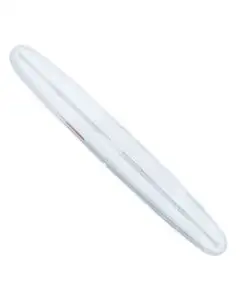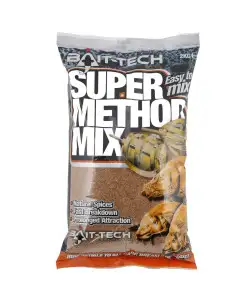This is a demo store. No orders will be fulfilled.
PVA Bags vs. PVA Mesh: Which is Right for You?

In the vast and evolving world of angling, enthusiasts are constantly on the lookout for innovative tools and techniques to gain an edge. Among these innovations, PVA (Polyvinyl alcohol) has emerged as an essential aid in bait presentation.
PVA allows anglers to strategically place and release their bait in water. The use of PVA products demonstrates how modern technology can revamp traditional fishing practices. However, as with all tools, the efficacy depends largely on the application, and here, the debate between PVA bags and PVA mesh takes centre stage.
How Does PVA work for fishing?
PVA, a water-soluble synthetic polymer, is unique in its ability to dissolve without leaving any toxic residues, making it environmentally friendly and ideal for fishing. In angling, PVA products are used to encase bait mixtures.
The PVA casing releases the bait at the desired location once the PVA dissolves in water. This ensures that the bait remains intact during the cast and settles effectively to attract fish.
Always ensure that your hands are dry when handling PVA products, as any moisture can start the dissolving process prematurely.


PVA Bag Fishing or PVA Mesh?
The choice between PVA bags and PVA mesh fishing is not merely a matter of personal preference but can significantly influence the outcome of a fishing expedition.
Both have their merits and applications, but understanding the nuances of each can mean the difference between a fruitful day at the water and going home empty-handed.
This article delves into the advantages and disadvantages of both methods, setting anglers up for success regardless of their choice. Join us as we navigate the waters of this compelling debate, casting light on which PVA product might just be the perfect catch for your next angling adventure.
What are PVA bags used for?


PVA (Polyvinyl Alcohol) bags are pre-sealed bags, typically transparent, that can be filled with bait and sealed.
These are used by anglers, especially those targeting carp, to deliver a small parcel of bait accurately to a chosen fishing spot. PVA fishing bags are water-soluble, meaning they dissolve upon contact with water.
When a PVA bag filled with bait is cast into the water, the bag dissolves, leaving a concentrated pile of bait in the vicinity of the angler's hookbait. This helps to attract fish to the hookbait and increases the chances of a take.
Benefits of PVA Bags for Carp Fishing
+ Convenience and speed.
+ Predetermined bait quantity.
+ Suitable for a mix of bait types.
+ Minimized tangle risks.


What is PVA mesh used for?


PVA (Polyvinyl Alcohol) mesh looks like a fine netting tube, which can be filled with bait.
Mesh is often used by anglers to create small parcels or "sticks" of bait. Like PVA bags, PVA mesh is primarily used for carp fishing but can be applied to other types of coarse fishing as well.
The mesh allows anglers to pack down a variety of baits, including pellets, crushed boilies, and groundbait mixes, into a tubular or stick shape. This bait-loaded mesh can then be attached to the hook or lead setup, ensuring that a concentrated amount of bait is delivered right next to the hookbait when cast out.
The holes in the mesh mean, that, unlike bags, the bait will not float and will read lower sections of the water column, where many fish tend to be hiding.
Benefits of PVA Mesh
+ Flexibility in bait quantity.
+ Easier to create stringers or chains of bait.
+ Allows for more free movement and dispersal of bait.
+ Can cater to different bait sizes more effectively.


Does PVA Mesh dissolve?
Yes, PVA mesh is water-soluble and will dissolve completely when submerged in water, leaving the bait behind in a tight cluster. This dissolution creates an attractive feeding spot for fish around the hook.
How To Choose Between PVA Bags and PVA Mesh
Type of fishing bait
Every bait has its unique texture, size, and consistency. Thus, not all of them are universally suited for both PVA bags and meshes. Let's delve into some popular bait choices and determine which of the two PVA products they pair best with:
- Boilies: These are hard, round baits typically made from a mix of cereals, fish meals, and flavourings. Given their solid nature, boilies are versatile. They can be used with both PVA solid bags and mesh, but many anglers prefer to use PVA bags when introducing a small number of boilies directly around their hookbait.
- Groundbait: This PVA bag mix of crushed ingredients like breadcrumbs, fishmeal, and various attractants offer a powdery and loose consistency, groundbait is best suited for PVA bags, which can hold the mix together and allow for a neat, compact presentation.
- Pellets: These are compressed feed ingredients formed into small cylindrical shapes. Depending on the size and type of pellet, both PVA bags and mesh can be used. However, for smaller pellets that risk spilling out or for a mix of pellet sizes, PVA bags might be a safer choice to ensure a tidy presentation.
- Maggots: These wriggly baits are a favorite for many species of fish. While they can be placed in PVA bags, maggots often fare better in PVA mesh. The mesh structure allows them to move and wriggle, creating an enticing visual and vibrational lure for the fish.
- Worms: Like maggots, worms benefit from the structure of PVA mesh. Their movement can attract fish, and the mesh offers enough room for them to wiggle and breathe, keeping them lively and appetizing for longer.


- Particles: This category includes a variety of small baits like seeds, nuts, and grains. Given their tiny size and potential to scatter, particles are generally better suited for PVA bags. The bags keep the particles together and prevent them from dispersing prematurely during the cast.
While there's some flexibility in pairing baits with either PVA bags or mesh, some pairings are more effective and convenient than others. By understanding the nature and behaviour of each bait, anglers can optimize their bait presentation and increase their chances of a successful catch.
Based on Water Conditions
The success of an angling adventure isn't solely based on the choice of bait but also on the intricate dance between the bait presentation and the environment. Among the key environmental factors to consider is the condition of the water.
Both PVA bags and PVA mesh offer unique advantages in varying water conditions. Here's a closer look at how each option performs:
Still Waters (e.g., Lakes, Ponds)
- PVA Bags: Ideal for still waters. They ensure the bait remains compact and descends straight to the bottom. This provides a tight baiting area, attracting fish to a specific spot.
- PVA Mesh: It can also be used effectively in still waters, especially when you want a slightly more scattered bait presentation. However, the bag generally offers a neater delivery in calm conditions.


Flowing Waters (e.g., Rivers, Streams)
- PVA Bags: Particularly useful when the water has a swift current. The bag's solid nature ensures that the bait isn't swept away immediately upon hitting the water, allowing it to settle effectively on the riverbed.
- PVA Mesh: In moderate currents, mesh can be effective, especially with live baits like maggots and worms that benefit from the movement. However, in strong currents, there's a risk that the bait might disperse too quickly before reaching the desired location.


Cloudy or Murky Waters:
- PVA Bags: Effective in such conditions as they create a concentrated pile of bait. The tight grouping can cause a noticeable disturbance or cloud in the water when it dissolves, attracting curious fish.
- PVA Mesh: Still functional, but the scattered presentation might be less discernible to fish in low visibility waters.
Clear Waters:
- PVA Bags: These can still be useful, especially if you're aiming to create a precise feeding spot.
- PVA Mesh: Tends to shine in clear waters, particularly with live baits. The slight scattering of bait can mimic natural food sources, enticing fish without making them wary.
By tailoring your bait presentation method to the environment, you align yourself with nature's rhythm, greatly enhancing your chances of making that prized catch.
Which fish types are more likely to be attracted to PVA?
The choice between PVA bait bags and PVA mesh isn't solely about the type of bait or water conditions; it's also intricately linked to the target fish species. Certain species exhibit preferences for the bait presentation, either due to their feeding habits or the environments they frequent.
- Carp: Renowned for their scavenging nature, are often drawn to the concentrated bait pockets provided by PVA bags, especially when filled with particles, boilies, or pellets.
- Bream and Tench: These fish sift through the substrate for food and are likely to be attracted to the dense baiting zones created by PVA bags.
- Predatory species: Pike or perch are enticed by movement and may respond more favourably to a PVA mesh presentation filled with wriggling maggots or worms.
- Roach and Rudd: Fish species that feed in shoals, might be attracted to the scattered bait presentation offered by PVA mesh, as it imitates a more natural food dispersion.
By understanding the preferences and behaviours of target fish, anglers can tailor their PVA product choice for maximum effectiveness.


What will dissolve PVA?
Although PVA (polyvinyl alcohol) is water-soluble, there are certain substances commonly found in baits that can also lead to the premature breakdown of PVA before it meets water.
- Oily Pellets: While the oil itself doesn't dissolve PVA, some pellets may have absorbed water during their production or storage, causing them to break down PVA.
- Fresh/Frozen Boilies: These baits might contain moisture from their ingredients or the freezing process, leading to premature PVA dissolution.
- Particles like Hemp and Maize: When freshly prepared, these can retain a significant amount of water which could start dissolving PVA.
- Salted Baits: Salt is hygroscopic and can pull moisture from the environment. When used in baits, the moisture can lead to PVA breakdown.
- Natural Fresh Baits like Worms and Maggots: These creatures contain natural moisture, which can cause PVA to dissolve. Coat them in plenty of groundbait to slow the breakdown of PVA.
To prevent PVA from breaking down prematurely, it's essential to ensure that baits are dry or to use PVA products that are more resistant to the specific bait you're using.
Some anglers use PVA-friendly oils or liquids to coat their baits and prevent them from dissolving the PVA until it's in the water.


Other Considerations for Choosing PVA Bait Presentation
Personal proficiency and experience: Your familiarity and skill level with PVA products can influence which option suits your style and offers you the best results.
Ease of use for beginners vs. experienced anglers: While PVA bags often provide a straightforward, mess-free experience ideal for novices, PVA mesh might appeal more to seasoned anglers seeking flexibility in bait presentation.
Cost considerations: It's essential to compare the initial and recurring prices of both PVA bags and mesh to ensure you make a cost-effective choice. Opt for some PVA mesh refills rather than a whole PVA mesh system each time to save money.
Overall costs of each option and long-term investment: While PVA bags might be more cost-efficient for occasional fishing trips, investing in PVA mesh could prove economical for regular anglers due to its reusability and adaptability to different baits.
When to Opt for PVA Bags?
If you're in situations with weed or debris, PVA bags shine:
· Weedy Waters: Bags protect the bait and ensure it reaches the lakebed without getting tangled.
· Silt Beds: Bags prevent the bait from sinking into the silt, presenting it more attractively to carp.
The Ideal Scenarios for PVA Mesh
PVA mesh works best when:
· Feeding Little and Often: Allows for frequent casting with different bait amounts.
· Varied Bait Presentation: Mixing up bait types in one parcel can be more enticing.
· Fishing in Clear Spots: Minimal risk of entanglement or the bait sinking into the silt.
Potential Drawbacks of PVA Bags and PVA Mesh
While PVA bags and mesh offer numerous benefits for bait presentation in angling, it's essential to explore their potential drawbacks to ensure an informed and successful fishing experience.
Negatives of PVA Bags:
- Limited flexibility in bait quantity: Pre-sized bags often dictate the amount of bait you can use, preventing on-the-spot adjustments based on conditions or intuition.
- Risk of bait compaction: Since the bait is packed tightly into the bag, there's a potential for baits, especially softer ones, to become compressed. This can alter the natural movement and appearance of the bait when the bag dissolves.
- Might not be suitable for all water conditions: In turbulent or very swift waters, the bag might not dissolve as effectively, leaving a residue or causing the bait to disperse unevenly.
- Greater expense: On a per-use basis, PVA bags can be more costly than mesh, especially if you fish regularly.


Downside to using PVA Mesh:
- Potential complexity in setting up for beginners: Getting the right tension, securing the ends, and ensuring the bait is properly encased can be challenging for novices.
- Might require more equipment or components: Beyond the mesh itself, anglers might need a plunger or a tube to help pack the bait. This can complicate the setup process and mean more gear to carry.
- Possible wastage if not used effectively: If not secured correctly, the bait can spill out, leading to wastage and potentially decreasing the chances of a successful catch.
- Less protection for delicate bait: Unlike bags, the mesh doesn't offer a protective barrier. Fragile baits like certain particles or groundbaits might get dispersed or crushed during casting.
- Slower dissolve rate: In colder water conditions, some PVA meshes may dissolve slower than bags, potentially delaying the bait presentation.


Tips for Using PVA Bags and Mesh Effectively
Navigating the intricacies of PVA products can be daunting for both novice and seasoned anglers. However, with a little knowledge and some practical insights, you can elevate your bait presentation game. Here are some tips to get the most out of your PVA bags and mesh:
1. Storage Solutions: One of the key factors that determine the longevity and effectiveness of your PVA products is how they're stored.
Always keep PVA materials in a cool, dry place, sealed in their original packaging or an airtight container. This not only preserves their integrity but also prevents them from absorbing strong odours, which could deter fish.
2. Bait Combinations: PVA products offer a platform for experimentation. However, it's wise to have a basic understanding of which baits work best with each method.
For instance, a mix of pellets and groundbait might be best suited for PVA bags, ensuring a compact and enticing bait pile. Conversely, wriggling live baits like maggots or worms are often more effective in a mesh, where their movement can be showcased.


3. Dissolve Dynamics: The rate at which PVA materials dissolve can be influenced by water temperature. In warmer waters, expect a quicker dissolve rate.
Conversely, in colder temperatures, the process can be slower. It's essential to take this into account, especially if you're aiming for a specific bait presentation timing. You can adjust the thickness or type of PVA product used based on the anticipated dissolve rate.
4. Casting with Care: The casting process can make or break your bait presentation. Proper technique is crucial. When casting, opt for a smooth, controlled motion to prevent tangles or the risk of rupturing the PVA, especially when using bags which might be more susceptible to tearing upon impact.
5. How to attach pva bag rig to main line
Follow the videos below to discover the steps to tying a solid PVA bag rig.
6. Preparation of PVA: Use short leadcore (or fluorocarbon) leaders with your PVA solid bag rigs, allowing you to pre-tie many bags at home and quickly attach them using a loop-to-loop method at the fishing site.
This preparation of your PVA bag leaders can be especially beneficial for overnight stays, letting you have few PVA mesh bags ready upon arrival and minimizing setup time on the bank.
7. Enhanced Attraction: Equip yourself with an assortment of oils, goos, and other PVA-compatible liquids. Inject these into your solid PVA bag prior to casting. This not only amplifies the allure of your bag but also provides a dual advantage of a liquid attractant alongside the food and hookbait contained within.
8. PVA Bags' Buoyancy: For solid bags, a small pop-up (12mm) or a critically balanced wafter hookbait is often ideal. Given the lightness and responsiveness of a small pellet pile, it's logical to have a similar hookbait. This ensures that fish are less cautious when approaching the hookbait, enhancing the chances of a successful catch.


Mastering the use of PVA bags and mesh is an art, but with these tips in your arsenal, you'll be well on your way to achieving angling success.
Do PVA bags pollute water?
PVA (polyvinyl alcohol) bags are designed to be water-soluble and biodegradable. When they dissolve in water, they typically break down into harmless compounds. Thus, in the context of their intended use for fishing bait presentations, PVA bags should not pollute the water.
1. Complete Dissolution: PVA bags are formulated to dissolve completely in water, but the rate of dissolution can vary based on water temperature and the specific formulation of the PVA. In very cold water, the bags might take longer to dissolve. However, they should eventually dissolve without leaving any residues.
2. Environmental Impact: While PVA itself is considered biodegradable and should not contribute to long-term pollution, the broader environmental impact depends on the additives and other materials that might be present in specific PVA products. It's always a good practice for anglers to choose products that are confirmed to be environmentally friendly.
3. Wildlife Interaction: Until they dissolve, there's a potential (though minor) risk of aquatic creatures or birds interacting with the PVA bags. This is generally a short window of time, given the rapid dissolution of most PVA products in water.


In summary, PVA bags shouldn't pollute the water. Nonetheless, anglers should always strive to minimise their environmental footprint and choose products known for their eco-friendliness.
When selecting between PVA bags and PVA mesh, it's crucial to evaluate your specific needs and desires for any given fishing excursion. Do you seek the precision of a tidy, compact delivery, or do you lean toward the adaptability of tailoring your bait load?
Understanding personal preferences and aligning them with the unique circumstances of your fishing scenario can significantly enhance your success rate. Moreover, there's value in experimentation. By alternating between both methods, you can better gauge what resonates with your style and yields the best results.
So, the next time you stand by a serene water body, eagerly anticipating the thrill of a bite, remember: it's not solely about the bait you choose but the finesse in its presentation. Whether you champion mesh or bags, cast your line with assurance. With knowledge and experience under your belt, those fish won't see you coming!
FAQs on PVA for Fishing
What is the best bait for carp in PVA bags?
- Boilies: These are dense, round baits that come in a variety of flavours and sizes.
- Pellets: Available in a range of sizes and flavours, they break down at different rates, creating a bed of attraction.
- Crushed boilies: Breaking up boilies can release more flavour and attractants into the water.
- Particles: Such as maize, hemp, or tiger nuts. However, ensure they are thoroughly soaked and prepared to be safe for the carp.
- Groundbait: A mix of crushed baits, often combined with other attractants.
How often should I recast with a PVA bag?
On average, if you're not getting bites or seeing activity after about 30 minutes to an hour, it might be worth recasting. However, this is a general guideline and can vary based on the specific conditions and environment.
- Bite rate: If you're getting bites quickly, you might need to recast more often to maintain the baited area.
- Presence of nuisance species: If smaller fish or species you're not targeting are consuming the bait quickly, you may need to recast more frequently.
- Observations: Watch for signs of fish activity around your baited area. If there's no activity after a reasonable amount of time, consider recasting.
How long should you leave the PVA bag out for?
The PVA bag itself will dissolve in the water within a few minutes, depending on the water temperature and the type of PVA product used. Cold water can slow down the dissolving process, while warm water speeds it up.
After casting, you'll want to wait until the bag is fully dissolved before expecting a bite. As for how long you should leave your baited rig out after the bag has dissolved. If you haven't had any action in 30 minutes to an hour, or if you believe the bait has been consumed or dispersed, it may be time to recast.
Always remember that fishing requires a blend of knowledge, observation, and intuition. While these are guidelines, each angling situation can be unique, so be prepared to adjust your tactics based on conditions and results.
How long does PVA Mesh take to dissolve?
On average, in moderate water temperatures, PVA mesh might take anywhere from a couple of minutes to about 20 minutes to fully dissolve. It's always a good idea to test the specific mesh you're using in the water conditions you're fishing in to get an accurate dissolution time.
· Water Temperature: In colder water, PVA mesh may take longer to dissolve compared to warmer water.
· Type of PVA: Some brands or types of PVA may dissolve faster than others.
· Mesh Size and Thickness: Thicker mesh or a tighter weave might take a bit longer to dissolve.
What rig to use with PVA Mesh?
When using PVA mesh, one of the best rigs for PVA bags and mesh is the hair rig. Here's a basic outline:
- Tie a standard hair rig with your chosen hook and length of hooklink material (like braid, fluorocarbon, or monofilament).
- Attach your chosen hookbait (like a boilie or pellet) to the hair.
- Once you have prepared your PVA mesh stick or parcel of bait, you can slide it onto the hooklink so that it sits just above or next to your hookbait.
- To attach the PVA mesh stick, some anglers pierce the mesh with the hook and then slide it up the hooklink. Others prefer to tie the mesh directly to the hooklink using PVA tape or string.
When casting out, ensure that the PVA mesh doesn't impact the water too forcefully, as this can cause the bait to disperse prematurely.
Using PVA mesh with a hair rig ensures that when the mesh dissolves, the bait is concentrated around your hookbait, increasing the chances of a fish taking your bait.
























